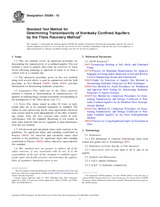Potřebujeme váš souhlas k využití jednotlivých dat, aby se vám mimo jiné mohly ukazovat informace týkající se vašich zájmů. Souhlas udělíte kliknutím na tlačítko „OK“.
ASTM D5269-15
Standard Test Method for Determining Transmissivity of Nonleaky Confined Aquifers by the Theis Recovery Method (Withdrawn 2024)
Automaticky přeložený název:
Standardní zkušební metoda pro stanovení propustnosti Nonleaky Napjaté kolektory podle Theis zotavení Metoda
NORMA vydána dne 15.4.2015
Informace o normě:
Označení normy: ASTM D5269-15
Poznámka: NEPLATNÁ
Datum vydání normy: 15.4.2015
Kód zboží: NS-590621
Počet stran: 5
Přibližná hmotnost: 15 g (0.03 liber)
Země: Americká technická norma
Kategorie: Technické normy ASTM
Kategorie - podobné normy:
Anotace textu normy ASTM D5269-15 :
Keywords:
aquifers, aquifer tests, confined aquifers, control wells, groundwater, hydraulic properties, observation wells, step tests, transmissivity, unconfined aquifers,, ICS Number Code 93.160 (Hydraulic construction)
Doplňující informace
| Significance and Use | ||||||||||||||
|
5.1 This test method is useful for analyzing data on the recovery of water levels following pumping or injection of water to or from a control well at a constant rate. The analytical procedure given in this test method along with several others is used in conjunction with the field procedure in Test Method D4050. 5.2 Assumptions: 5.2.1 The well discharges at a constant rate, 5.2.2 Well is of infinitesimal diameter and is open through the full thickness of the aquifer. 5.2.3 The nonleaky aquifer is homogeneous, isotropic, and extensive in area. 5.2.4 Discharge from the well is derived exclusively from storage in the aquifer. 5.2.5 The geometry of the assumed aquifer and well are shown in Fig. 1. 5.3 Implications of Assumptions: 5.3.1 Implicit in the assumptions are the conditions of radial flow. Vertical flow components are induced by a control well that partially penetrates the aquifer, that is, not open to the aquifer through the full thickness of the aquifer. If vertical flow components are significant, the nearest partially penetrating observation well should be located at a distance, 5.3.2 The Theis method assumes the control well is of infinitesimal diameter. The storage in the control well may adversely affect drawdown measurements obtained in the early part of the test. See 5.3.2 of Test Method D4106 for assistance in determining the duration of the effects of well-bore storage on drawdown. 5.3.3 Application of Theis Recovery Method for Unconfined Aquifers: 5.3.3.1 Although the assumptions are applicable to artesian or confined conditions, the Theis solution may be applied to unconfined aquifers if (A) drawdown is small compared with the saturated thickness of the aquifer or if the drawdown is corrected for reduction in thickness of the aquifer and (B) the effects of delayed gravity yield are small. See 5.3.3 of Test Method D4106 for guidance in treating reduction in saturated thickness and delayed gravity drainage in unconfined aquifers. Note 1: The quality of the result produced by this standard is
dependent on the competence of the personnel performing it, and the
suitability of the equipment and facilities used. Agencies that
meet the criteria of Practice D3740 are generally considered capable of
competent and objective testing/sampling/inspection. Users of this
standard are cautioned that compliance with Practice D3740 does not in itself assure reliable
results. Reliable results depend on many factors; Practice
D3740 provides a means of
evaluating some of those factors.
|
||||||||||||||
| 1. Scope | ||||||||||||||
|
1.1 This test method covers an analytical procedure for determining the transmissivity of a confined aquifer. This test method is used to analyze data from the recovery of water levels following pumping or injection of water to or from a control well at a constant rate. 1.2 The analytical procedure given in this test method, along with several others, is used in conjunction with the field procedure in Test Method D4050. Guide D4043 provides information for determining hydraulic properties. 1.3 Limitations—The valid use of the Theis recovery method is limited to determination of transmissivities for aquifers in hydrogeologic settings reasonably corresponding to the assumptions of the Theis theory (see 5.2). 1.4 Units—The values stated in either SI Units or inch-pound units are to be regarded separately as standard. The values in each system may not be exact equivalents; therefore each system shall be used independently of the other. Combining values from the two systems may result in non-conformance with the standard. Reporting of test results in units other than SI shall not be regarded as nonconformance with this test method. 1.5 All observed and calculated values shall conform to the guidelines for significant digits and rounding established in Practice D6026. All observed and calculated values shall conform to the guidelines for significant digits and rounding established in Practice D6026, unless otherwise superseded by this standard. 1.6 This standard does not purport to address all of the safety concerns, if any, associated with its use. It is the responsibility of the user of this standard to establish appropriate safety and health practices and determine the applicability of regulatory limitations prior to use. |
||||||||||||||
| 2. Referenced Documents | ||||||||||||||
|
Doporučujeme:
EviZak - všechny zákony včetně jejich evidence na jednom místě
Poskytování aktuálních informací o legislativních předpisech vyhlášených ve Sbírce zákonů od roku 1945.
Aktualizace 2x v měsíci !
Chcete vědět více informací? Podívejte se na tuto stránku.




 Cookies
Cookies
